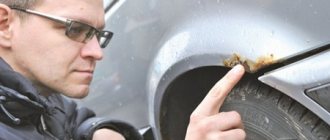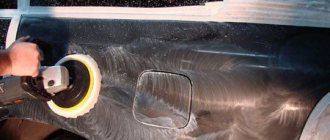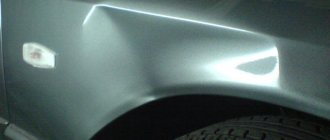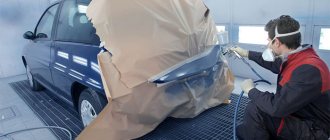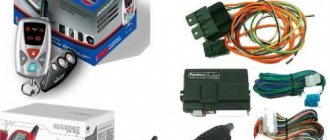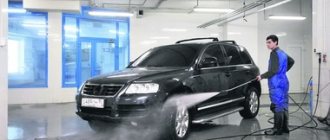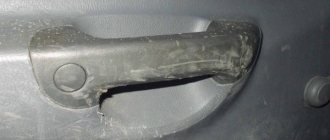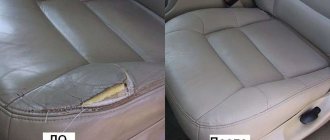No comments
Rating:
Polishing a car has a variety of purposes - there are a large number of types and methods of this procedure, and each of them helps to solve a specific problem. Among the most common tasks of this procedure are the following:
- elimination of scratches and abrasions - using abrasive materials, a thin layer of paint is removed, due to which the microrelief is leveled and the surface becomes smooth;
- applying a protective layer to the car’s paintwork – protective types of polishes form an elastic film that helps neutralize the effects of external factors;
- giving the paintwork depth of tone and glossy shine. Compare the appearance of an old car before and after applying polish - you will see that it looks no worse than a new car. This procedure is performed before selling the car - owners often successfully use this technique.
After painting, even the most high-tech, it can be difficult to avoid some obvious defects.
As with any other type of surface treatment, there are pros and cons. The positive points include:
- elimination of minor mechanical defects;
- glossy shine and depth of color;
- protection from moisture, corrosion, burnout, dirt, etc.
The disadvantages include the gradual thinning of the paint layer, which ultimately leads to the need to repaint the car. In addition, the polishing method eliminates defects whose depth does not exceed the thickness of the paint - to get rid of deep scratches, you will have to resort to other methods.
See also:
Polishing a car with a grinder
Restorative polishing
Restorative polishing is a professional comprehensive body treatment that involves a series of procedures aimed at restoring its condition. It is also called pre-sale, since it allows you to return the car to its original attractiveness.
Like any other task, polishing requires careful preparation.
The correct technology is based on a preliminary analysis of the condition of the surface and drawing up a complete map of measures aimed at its restoration. It includes the following operations:
- Deep abrasive treatment to remove scratches and other mechanical defects. It is performed locally if the condition of the body is acceptable, or globally when there are a large number of small defects.
- A soft finishing treatment to eliminate micro-scratches that were formed as a result of exposure to abrasive material and to obtain a high-quality mirror surface.
- Protective – applying a finishing coating that will protect the paintwork from negative influences.
Abrasive restoration is carried out manually or using a grinding machine, special pastes and wheels with a given degree of grain size. This is necessary to ensure the required productivity and uniformity. Applying protective agents is a light rubbing process that is best done manually.
See also:
Abrasive car polishing
Express polishing
The name speaks for itself. This is a quick and simplified procedure that gives the body a shine. It returns the original color and shine, but scratches and other damage are not removed, although light scratches on soft varnish can and will be removed with this type of polishing. It takes up to 5 hours, including preparatory washing and degreasing of the body. Suitable for those who only need to slightly refresh their car in order to enjoy the shine or give it a pre-sale shine. Mainly used as pre-sale preparation of a car.
Below you can see an example of express polishing on a Toyota Camry:
What does abrasive car polishing look like?
Removing defects using abrasive materials is as follows:
- First, you should thoroughly wash the car and dry it;
- using white spirit, degrease the surface to remove substances that could not be removed by washing - tar, bitumen, machine oil, etc.;
It is imperative that before you start polishing the car, you must thoroughly wash the body so that the smallest particles of dirt and dust do not deform the paint surface during the procedure.
- Perform a detailed inspection of the body and use a washable marker to mark the areas that need to be treated;
- Lubricate the area with the scratch with abrasive paste with the maximum grain size;
- take a sander and apply a little paste to the wheel, then polish with even, gentle movements until the scratch disappears. At the same time, carefully ensure that the treated area has smooth exits - it should not take the form of a depression;
- after this, use pastes and wheels of decreasing grain size;
- finishing involves gentle processing to remove microgrooves from previous materials;
- The final stage is non-abrasive polishing, which uses ceramic, Teflon, quartz polish or car wax as a final protective coating.
See also:
Soft car polishing
How to Polish a Car with a Sander
Welcome, friends, to our homemade car repair website. Today, a car is not only a means of transportation, but also an indicator of the social status and respectability of its owner.
Pleasant to the eye color, ideal shape, shiny, completely smooth surface - such properties serve as a source of pride in your own “iron horse”.
polish correctly
car
But a car is not a decorative product that is stored only in suitable conditions, where it is not threatened by rapid deterioration of all properties.
The environment for using a car is an open place with full negative impacts, including both weather changes and a huge number of man-made and other reasons.
Traces of frequent washing, scratches acquired during careless loading or from tree branches, chips, stains can simply spoil the car owner’s mood.
However, there is an option to correct the situation by resorting to polishing - a process that results in the reconstruction or restoration of the coating.
However, not all car owners decide to carry out a similar process without the help of others, but trust only specialists from a car service center, and think that only they know how to polish
car.
In reality, any car owner will do this at home, you just need to follow the main rules, and of course listen to advice and tips.
Polishing is carried out not only for cosmetic purposes, it also includes a technical procedure that protects against damage to the enamel, leading to the formation of rust. In addition, if such a need arises, they polish the headlights and sometimes car windows.
Covering the car with the bulk of the body surface prevents the corrosion process, but the paint is quite easily covered with small cracks.
It is into such minor imperfections that various substances penetrate, which trigger a seemingly inconspicuous, but rapidly progressing corrosion process.
The prerequisite for this is dirt and dust, which have abrasive properties, which, in the absence of proper care, renders the coating unusable.
Additionally, the direct negative influence of sunlight over a long period of time can also reduce the shine of a car’s surface.
Of course, the work of polishing a car can be roughly divided into four steps:
- Preliminary step;
- Grinding;
- Polishing;
- The final step.
First, you need to prepare not only the car, but the room where the polishing is performed, based on 3 criteria: lighting, space and cleanliness.
Because the parts of the car, both upper and lower, will be polished, which is why it is better to install good lighting in the garage.
Polishing the body after painting
The car painting technology ultimately allows for some unevenness in the microrelief, which is expressed in the form of the following disadvantages:
- shagreen;
- drips;
- specks of dust;
- varnish failures, etc.
Experts say that you can polish a car no more than twenty times, after which it is recommended to completely renew the paintwork. Therefore,
at the end, the surface must be mechanically treated using polishes, the goal of which is to achieve a smooth mirror effect. This procedure is not recommended to be performed earlier than 3-4 weeks after painting - during this time the enamel and varnish have time to finally harden and are ready for further work. At its core, post-paint finishing is no different from restorative finishing - it has the same tasks and the same technology.
See also:
Polishing and varnishing headlights
Polishing tools and materials
The first thing you need to do is to prepare properly so as not to interrupt the process for trips to the car store. For deep polishing you will need the following tools and accessories:
- Sander;
- attachments for the machine;
- polishing paste with abrasive;
- detergents;
- lint-free napkins and rags;
- wax based polish.
A grinding machine for polishing a car body must have a spindle speed regulator. If there is none, then you should make sure that the rotation speed is within 1700 rpm. If the speed is significantly higher than this parameter, then there is a risk of seriously damaging the car’s paintwork, or simply burning it.
The attachments are purchased in the form of foam circles, which are attached with Velcro to the machine. You may also need rag attachments for final polishing. Polishing paste is selected in accordance with the selected wheels, and here preference should be given to brands that have positive consumer reviews. For example, you can select those that are used by the wizards in the video. Particular attention should be paid to cars that are painted metallic or pearlescent - there are special abrasive pastes for such coatings.
Detergents are also mandatory, and in order to polish the car body correctly and efficiently, it must be washed before starting work, and then again after the procedures. As detergents, it is advisable to use proven shampoos or other liquids intended specifically for car paintwork.
Napkins and rags are necessary for rubbing the applied paste, for removing its excess, and also for working with wax polishes. They should be soft and definitely not leave streaks or lint; for this, it would be best to purchase special rags from automotive stores.
Wax polishes will be needed to apply a protective layer to the car body at the last stage of polishing, and attention should be paid to the quality of the product. Such polishes are usually liquid and packaged in aerosol cans.
Polishing car headlights and other elements
To return the surface to its original smoothness, eliminating chips and abrasions on the paint surface, treat the paintwork of one element:
- doors;
- torpedoes;
- wing, etc.
The first thing you need to do is wash and dry the headlight.
The same is done after local painting when painting over defects whose depth exceeds the thickness of the paintwork. After this, they are covered with a layer of finishing polish, which forms a protective film. The tightness of such a film is a guarantee of minimizing the negative effects of moisture, ultraviolet radiation, dirt, etc.
These types of treatments are also used for varnish coating of wheel rims, chrome parts, housings of plastic interior elements, dashboard, bumper, etc.
Abrasive materials are used to restore optics. Over time, scratches and chips also appear on it, which are caused by the following factors:
- dust particles in the oncoming air flow;
- bush branches;
- impacts of gravel and crushed stone, etc.
If the defects are minor, you can try polishing the car headlights without the sanding process
Shallow micro-irregularities are removed using a grinding machine and abrasive paste - this method is used for plastic and glass headlights. In this case, great care should be taken - with an excessive number of revolutions of the circle, the glass may overheat and burst.
See also:
Grinding and polishing glass headlights
Types of polishing
First of all, you should understand the variety of polishes, which can be roughly divided into three types:
- deep car polishing;
- surface polishing;
- protective polishing.
Protective polishing involves applying a product containing wax fillers to the car body. If this procedure is carried out regularly and correctly, then there will always be a protective layer of wax on the surface of the paintwork, which acts as a barrier to moisture and weak mechanical influences. This type of car polishing is simple, and to master it, just watch the videos of the masters.
Surface polishing is carried out using abrasive pastes, the composition of which allows you to remove a microscopic layer of varnish.
In this way, it is reasonable to polish a car body that has small scratches that have not reached the base coat of paint. By removing the varnish layer, this treatment eliminates scratches and gives the coating a new effect.
The most difficult type of processing is deep polishing. In this case, you can remove more serious scratches and even small chips on the surface of the car. For such polishing, several different products are used in succession. To properly polish a car body using this method, you must strictly follow certain instructions, which are briefly outlined below. Additionally, before starting work, you should familiarize yourself with popular videos on the topic.
Car glass polishing
It should be noted that, along with other elements of the car, windows can also be removed and protected from scratches. Using polishes you can remove abrasions and scratches from the surface of any glass:
- wind;
- lateral;
- rear
Like other elements of the car, glass is exposed to external mechanical factors. For example, grains of sand and dust particles in the flow of oncoming air abrade the surface of the windshield, losing transparency - it becomes covered with a network of micro-potholes and scratches.
Grinding allows you to remove scratches and other imperfections from auto glass.
To return glass to its former smoothness and transparency, the same polishing methods that we discussed above are used. Using a grinding machine, abrasive pastes and wheels, the top thin layer of glass is removed and its surface becomes smooth again.
When working with a grinding tool, you should be extremely careful with the number of revolutions. If it is too high, the glass may overheat and break. In this case, it will not be possible to save it - you will simply have to replace it.
After imperfections are removed from the surface of the glass, it is covered with special protective agents - this can be anti-rain or other nanoceramic coating that can protect the windows from the appearance of new defects.
See also:
DIY car polishing tool
Preparing the machine for polishing
Before you start polishing your car, you need to wash it thoroughly; after washing, the surface should be dried and cooled to normal temperature. It is better to polish the car in a cool room. Often the main enemy of high-quality polishing is flying dust, so wet cleaning is mandatory.
It is highly not recommended to carry out this procedure in the open air. Firstly, there is too much dust on the street, which acts as a source of new scratches, and secondly, the sun’s rays fall on the body, which heats the paintwork, which negatively affects the action of the abrasive paste - it dries out.
Polishing car plastic
As you know, small defects appear on plastic much faster than on glass or metal - this material is characterized by softness and is susceptible to various types of mechanical damage.
Today, polishing plastic with your own hands is quite simple, since there are a huge number of different products and equipment on sale.
To clean the plastic interior, as well as plastic parts on the outside of the car from scratches, special polishes are also used that can return the material to its original smoothness and glossy shine.
See also:
How to polish headlights yourself - polishing methods
Car polishing paste - how to choose
To choose a car polishing product, you should first decide which parts you plan to process - different materials are used for the paintwork of the body, headlights, glass or plastic.
If you need to get rid of minor defects, first you will need to use an abrasive agent - 3m polish, clay, GOI paste, etc. The grain size depends on the depth and nature of the damage - the larger the scratches, the larger the grain size you need to choose. Accordingly, the more intermediate options there will be, since the risks and grooves from a coarse-grained abrasive are removed with a finer one.
After you have returned the surface to its original smoothness, you will need to treat it with a finishing protective layer to provide protection from new damage. There are many options here - some use liquid glass, others like a wax finish, and there are supporters of polymer coatings.
The most popular today are polishes with a paste composition.
When choosing a finishing product, they are usually guided by two criteria - naturalness or durability. Wax is a natural material, which, however, is extremely short-lived and needs to be renewed regularly. Liquid glass lasts more than a year, but it cannot be classified as a natural chemical.
See also:
Car polishing attachments
Do-it-yourself protective polishing of a car
The grinding technology does not hide any secrets. In fact, the process is quite simple, although it urgently requires vigilance and painstaking fulfillment of all points from the car owner, and also, of course, accuracy, since the car is still personal. Before polishing, it is necessary to thoroughly wash and then dry the body, having cleared all bitumen deposits in advance.
It is not allowed to polish in the sun, in frosty weather or in high humidity. An exemplary option is to carry out these operations in a garage.
The polish must be applied to the surface using soft applicators; however, sanding should be done with a dry and soft cloth. During this process, you will need to periodically change the sanding sponge to avoid the formation of a cloudy film. The polish on the body must be applied sparingly, applying equal diligence in all areas. It is preferable to start from the roof, going down evenly.
Is a car polishing machine necessary?
A sander is a tool that is not required, but its presence is highly desirable. Without a machine, work productivity will be much lower - you will spend much more time manually on the same amount of work. In addition, in some cases you will not be able to achieve the required uniformity - you will definitely need such a tool to polish headlights.
For such work, an eccentric pneumatic machine with an orbital movement pattern of the working plane is usually used - it rotates not only around its axis, but also moves around it in a certain orbit. Practice has shown that this type of grinder is the most convenient and productive in the types of work described.
Additional tool for car polishing
To perform polishing work, you will need to stock up on the following materials and tools:
- several types of polish;
- chemicals for degreasing;
- rags and microfiber;
- accessories for work - brushes for rubbing pastes, etc.
Do not forget also about protective equipment: glasses for your eyes, gloves for your hands and a respirator. They are necessary so that you do not harm your health during the work process and complete the task without unpleasant surprises and emergency situations.
Author: Semin Viktor Yurievich
Education: Samara Road Transport College. Telecommunications and electronics engineer. Second category driver/car mechanic. Skills in repairing domestically produced cars, chassis repair, brake system repair, gearbox repair, bodywork...

